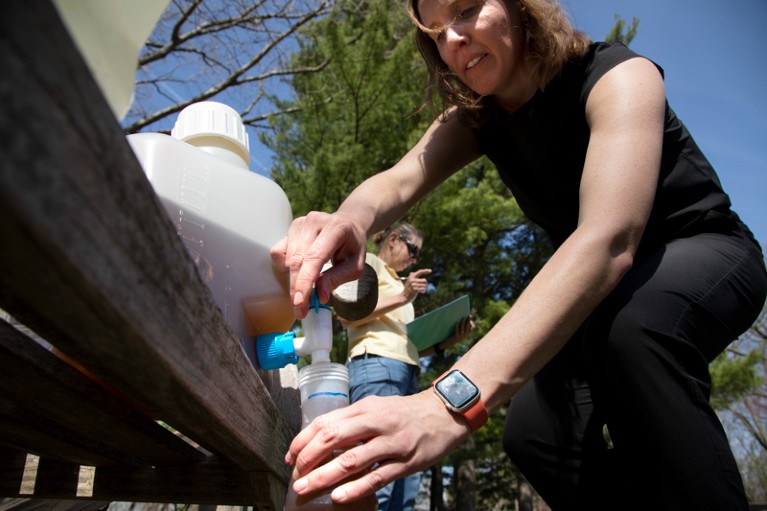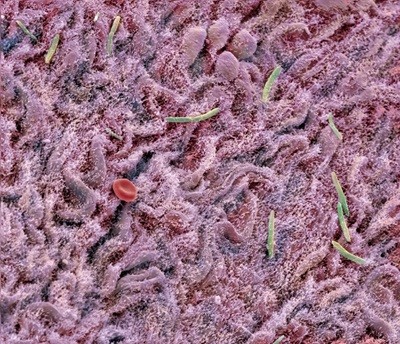As Mathilde Poyet takes me through the Global Microbiome Conservancy's laboratory in Kiel, Germany, I encounter all sorts of state-of-the-art equipment. It is an impressive facility with typical laboratory equipment such as incubators, state-of-the-art sequencing machines, and anaerobic chambers for culturing bacteria. But the most important things in the laboratory are stored in the freezer at −80 ºC. The samples are so important that there is a battery backup system so that if the power goes out in the freezers, the materials will remain intact. These test tube samples aren't some kind of immortality serum or cancer-fighting bacteria: they're feces.
More precisely, they are suspended stool samples and bacteria obtained from feces. But at one point it was feces that Poyet and her colleagues, including her partner Mathieu Groussin, collected as part of their work at the Global Microbiome Conservancy (GMbC), which Groussin co-founded. Poyet likes to call this project their “first baby” (one of their real children, their young daughter Aelis, is joining us in the office as we speak).
“We saw all kinds of feces on the Bristol Stool Scale—all shapes, all sizes, all colors,” Poyet says, referring to the stool classification chart doctors use to evaluate digestive problems.
Poyet and Groussen's work is based on the idea that feces provide a perfect snapshot of the human gut microbiome: the genetic content of the community of organisms that live in the gut. This varies depending on the population1 and can serve as an indicator of health. Most studies of the human gut microbiome have focused on populations of European ancestry. But GMbC requires samples to be more globally representative. The samples in the freezer come from as far away as Ghana, Tanzania, Finland and Thailand.
Samples are collected and frozen for the GMbC waste biobank.Photo: F. Rondon/Global Microbiome Conservancy.
Over the last nine years of the program, the team sampled 50 populations from 19 countries. Its members worked with local scientists, ethics boards and communities to collect samples, and used cars, boats, helicopters and even ATVs to collect samples. Back in the lab, the researchers analyze the stool contents, sequence the genetic material of the bacteria grown from the samples, and store the live samples in their biobank.
To outsiders, constant stool sampling may seem (and smell) disgusting. In Kiel, scientists occasionally make “poop soup” using a vessel called a bioreactor to see the effect of different scenarios on the harvested bacteria. They only do this a few times a year because the process can be long and expensive and the smells are strong, prompting their more traditional floormates to nickname the workspace the “smelly lab.”
But feces provide a remarkable insight into human health. “This is our best way to find out what's in the gut in healthy people,” says Groussen. “It’s a little rough around the edges, but it’s our best way to access this incredible and important biodiversity.”
A godsend for science
Since the microbiome is a trendy research topic, other scientists samples are being collected all over the world for self-study. And, as has been seen during the COVID-19 pandemic, wastewater analysis is a valuable public health tool, providing scientists with the means to monitor pathogens in populations before infections surge.
“The waste we put into the environment is really rich in data,” says Janelle Thompson, an environmental microbiologist at the Asian School of Environment at Nanyang Technological University in Singapore. Thompson and her team are taking samples of Singapore's wastewater to detect harmful microorganisms in the environment and looking for biological “signals” from organisms or viruses released from the human body.
“You can identify where the signals occur and track them over time to see when they occur,” she explains. For example, in 2021 and 2022, Thompson and her colleagues were able to identify SARS-CoV-2 coronavirus variants of concern on university campuses and wastewater treatment plants.2. According to the team, this was long before these variants became dominant, indicating “minimal silent circulation.”
The implications of human waste research span multiple scientific disciplines. Amid global fertilizer shortages, some scientists (and farmers) are keen to urine as fertilizerdue to its nitrogen content. Research in Nature Water3published earlier this year by a team of researchers from Stanford University in California, created a prototype system that extracts nutrients from urine. The team estimates its design could yield up to $4.13 per kilogram of nitrogen recovered. And studies published in 20204 shows that urine-based fertilizers can also help conserve other resources, reducing greenhouse gas emissions and water consumption.

A researcher pours urine-based fertilizer into a bottle.Photo: Marcin Szczepanski/Lead Multimedia Storyteller, Michigan Engineering
Stool samples are being used not only as a public health indicator, but also in developing a potentially life-saving treatment for infections Clostridia difficultby transferring healthy fecal bacteria and other microbes from one host to another.
C. difficult infections “are actually caused by a disruption of the microbiota,” explains Josbert Keller, a gastroenterologist at the Haaglanden Medical Center in The Hague, the Netherlands. Keller was part of the team that published the early clinical study.5 into the effectiveness of fecal transplantation, also known as fecal microbiota transplantation, in 2013. “If the patient cannot restore this microbiota, then it can recur and recur, and this is the point where fecal microbiota transplantation can actually cure the patient.”
Fecal transfers are now being considered as a treatment for obesity.6type 2 diabetes7Parkinson's disease8 and other conditions.
How to restore a gut microbiome destroyed by antibiotics
What is often perceived as disgusting can actually have great intrinsic value, says Bryn Nelson, whose 2022 book Flash: The Remarkable Science of an Incredible Treasure was described by the publisher as “an urgent exploration of the world's single most wasted natural resource.” Through a process of research and writing, the former microbiologist spent years studying the use of feces and discovered at least 24 areas that glean important information from what we think of as waste. Speaking about the “nuisance” factor of excrement, he says: “We just need to get over that hurdle to discover all the information it contains.”
Entering the field
Poyet was born in a wet lab. For her PhD, she studied the fruit fly. Drosophila suzuki and often spent entire days dissecting insect specimens. Her research now involves sifting stool samples to access bacteria that are not exposed to oxygen. Some samples are dirtier than others, she says, adding: “What's really disgusting about working with stool samples is that people don't digest the food, and you can find almost intact food in the stool. I really don't like that.”
For Thompson, working with waste also came naturally. “I’ve always been fascinated by the microbial world and then accessing it for the benefit of humans,” she says. “Germs are slippery, and they can smell, but I don’t find them disgusting.”
Stool and urine are also things that people become less sensitive to over time. Chong Chun Wee, a microbiome researcher at Monash University Malaysia in Subang Jai, is overseeing the collection of stool samples as part of his work on the human microbiome. His research focuses on how the gut microbiome varies across ethnic groups.9 in the region. Unlike Poyet and Groussen, he does not do field work. Instead, the vials are sent to donors, who give their samples at home but still need to be processed in a laboratory.
“The more you do it, the more you get used to it because it’s something you do regularly,” he says.
Your friends shape your microbiome, and so do their friends.
Marissa Ledger, a medical microbiology resident at McMaster University in Hamilton, Canada, studies the history of parasitic infections. Ancient fossilized fecal samples—decomposed organic components that resemble soil—can prove incredibly valuable in archeology and paleontology. Ledger's undergraduate degree was in anthropology, studying skeletal remains. She soon learned that studying parasites in preserved feces was the best way to chronicle infectious diseases throughout human history, comparing fossilized feces to time capsules that could provide detailed information about infections and diet in a society.
“When I decided I wanted to study parasitic infections, realizing that in the past they had to be a huge contributor to disease, I was more like, 'This is a really cool goal,'” she says. “I never thought it was rude until people said to me, 'Are you studying ancient poop?' This is crazy.”
There is a stronger one cultural taboo to poop, not urine, notes Marine Legrand, an anthropologist at OCAPI, an interdisciplinary action and research program in Paris that studies ways to recycle human waste, such as using urine as fertilizer. Although funding for fecal research is available, it appears to be geared more towards medical than agricultural applications. “When we look for products, it’s easier to find products to work with urine than to work with poop.”










